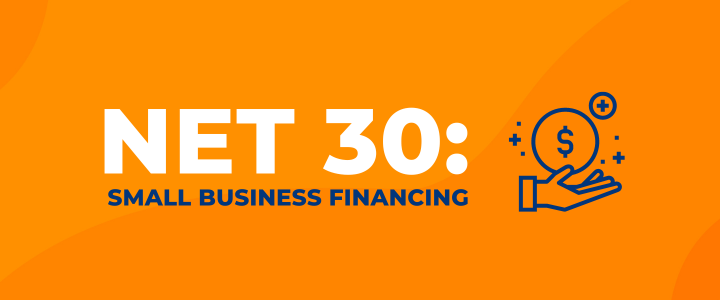As a small business owner, securing the right small business financing can significantly influence your growth trajectory and alleviate typical financial strains.
Understanding and applying concepts like Net 30 payment terms can transform complex cash flow challenges into manageable, even advantageous, components of your business strategy.
This guide aims to explore the essentials of Net 30 payment terms, providing insights on how they operate, their benefits, and how they can be strategically implemented to bolster your business’s financial health and expansion potential.
Small Business Financing Overview
Small business financing is a broad arena, involving various methods through which entrepreneurs secure needed funds for operational and growth purposes.
This includes covering operational costs, purchasing inventory, expanding market reach, or even smoothing out the inconsistencies of seasonal cash flows.
The importance of such financing cannot be overstated; it’s the lifeblood that supports small businesses at various stages of growth, allowing for scalability and stability in the competitive marketplace.
Understanding Small Business Financing

What is Small Business Financing?
Small business financing refers to the assortment of ways entrepreneurs secure funds to initiate, manage, and grow their enterprises.
These funds cover diverse necessities like startup costs, equipment purchases, electronics upgrades and cash flow optimization. Financing acts as a vital lifeline for small businesses, offering the necessary capital to transform concepts into reality, crafting a memorable brand, navigate financial barriers, and grasp opportunities for expansion.
Without adequate financing, small enterprises might find it challenging to compete and innovate, potentially risking their sustainability in a competitive landscape.
Types of Small Business Financing
Small businesses can explore a variety of financing options, including:
– Traditional Loans: Offered by banks and credit unions, these loans usually provide lower interest rates but often require collateral and a solid credit history.
– Business Lines of Credit: These allow businesses to borrow up to an agreed limit and only pay interest on the amount used, providing flexibility.
– SBA Loans: Facilitated by the Small Business Administration, these loans are government-backed, reducing the risk for lenders and easing qualification criteria for borrowers.
– Invoice Financing: This method enables businesses to use unpaid invoices to secure immediate funding, enhancing cash flow.
– Merchant Cash Advances: These advances give quick access to capital in exchange for a portion of future credit card sales.
– Crowdfunding and Peer-to-Peer Lending: These platforms connect borrowers directly with investors or lenders, bypassing traditional financial institutions.
Choosing the Right Financing Options
Selecting the appropriate financing options requires careful consideration of several factors:
– Interest Rates: These can significantly affect the total cost of borrowing.
– Repayment Terms: The duration and flexibility of repayment impacts monthly financial obligations.
– Collateral Requirements: Some loans necessitate collateral, which can risk valuable assets.
– Credit Score Impact: A good credit score is often crucial for favorable loan terms and interest rates.
What is Net 30 Terms?
Net 30 terms are a type of trade credit predominantly utilized in business-to-business (B2B) transactions, permitting buyers to pay for goods or services 30 days post-invoice.
This arrangement benefits both sellers, who can offer credit to reliable customers to boost sales, and buyers, who enjoy the flexibility of delayed payment, aiding in better cash flow management.
Often, suppliers might incentivize early payments with discounts, like “2/10 net 30”, which offers a 2% discount if paid within ten days.
These terms not only assist in managing operating expenses without immediate outlay but also support businesses in building a strong credit profile, crucial for future financial endeavors.
Importance of Combining Small Business Financing with Net 30
The strategic use of Net 30 payment terms in conjunction with other small business financing methods provides a robust foundation for managing and growing your business.
Net 30 terms offer businesses the flexibility to manage their cash flows more efficiently, easing the burden of immediate payments and giving them the breathing room to align their income with outgoings.
When combined with other financing mechanisms, Net 30 can be a crucial tool in a comprehensive financial strategy.
Integrating Net 30 with other financing options such as traditional loans, SBA loans, or even lines of credit can help businesses bridge the gap between receivables and payables.
This synergy not only boosts cash flow but also maximizes financial sustainability and growth potential. It offers businesses the ability to take on larger projects or orders without the stress of upfront expenditures.
Businesses can also leverage Net 30 to build a positive credit history by ensuring timely payments, which in turn can improve their credibility and attractiveness to lenders and suppliers.
Overall, combining these financing options with Net 30 terms provides a multi-faceted approach to financial management that supports both immediate needs and long-term growth.
Traditional Loans and Alternative Options
Traditional loans from banks and credit unions are a common source of funding for small businesses. These loans often come with competitive interest rates and terms but might require thorough documentation and strong credit scores.
Simultaneously, alternative financing options such as business lines of credit provide a flexible funding solution where businesses can draw funds as needed and pay interest only on the amount used.
Moreover, invoice financing is another strategic option, allowing businesses to borrow against the value of their outstanding invoices, providing immediate operating cash without waiting for customer payments.
Each of these options has its unique advantages and can be suited to different types of business needs and situations.
The Role of SBA Loans and Government-Backed Financing
SBA loans, partially guaranteed by the Small Business Administration, are designed to provide easier access to capital for small businesses that might not qualify for traditional loans.
These loans are renowned for their favorable terms, including lower down payments, extended repayment terms, and built-in support services.
They can be particularly beneficial for new businesses and those looking to grow or recover from adversity, with programs tailored for various business needs, from disaster recovery to expansion funding.
Exploring Merchant Cash Advances and Crowdfunding
Merchant cash advances and crowdfunding represent more unconventional financial resources. A merchant cash advance provides fast access to capital based on future credit card sales, suitable for businesses with high credit card sales volumes.
Although convenient, the costs can be higher than traditional loans, making it crucial for businesses to understand the terms fully.
On the other hand, crowdfunding leverages the power of the internet to raise small amounts of money from a large number of people, often facilitated through platforms like Kickstarter or GoFundMe.
It’s particularly useful for businesses with innovative products or services that resonate with a broader audience, providing a platform not only for raising funds but also for marketing and validating new ideas.
Net 30 Terms Explained
What are Net 30 Terms?
Net 30 terms are a type of trade credit often used in business-to-business (B2B) transactions, where the buyer has 30 days from the invoice date to pay the vendor for the goods or services purchased.
This arrangement helps businesses manage their cash flows by allowing them to receive goods immediately and pay for them later, typically without interest if paid within the standard 30-day period. It not only aids in smoothing operational finances but also in establishing a trust-based relationship between suppliers and buyers.
Benefits of Net 30 Terms
There are several advantages to using Net 30 payment terms for small businesses:
– Cash Flow Management: Net 30 terms can help businesses better manage their operational budget by providing up to a 30-day window to gather financial resources.
– Building Business Credit: Regular and timely payments of Net 30 invoices can positively impact a business’s credit rating, making it easier to obtain favorable financing in the future.
– Enhanced Supplier Relationships: Consistently meeting payment terms can lead to stronger relationships with suppliers, possibly resulting in better prices or favorable terms in future dealings.
Challenges of Net 30 Terms
While beneficial, Net 30 terms can present certain challenges:
– Cash Flow Gaps: Delays in payment from customers can create cash flow gaps, especially if a business is heavily reliant on a few big clients.
– Credit Risk: Offering Net 30 terms involves credit risk, particularly if the buyer’s creditworthiness is not adequately assessed.
– Negotiations with Suppliers: For newer businesses, negotiating Net 30 terms may be challenging without a solid credit history or purchasing volume.
Integrating Small Business Financing with Net 30

Utilizing Financing to Manage Net 30 Terms
Integrating different financing options can offset some inherent risks of Net 30 terms:
– Business Lines of Credit: These can provide a cushion when awaiting payments, allowing businesses to continue operations smoothly.
– Invoice Financing: This enables companies to borrow against invoices issued under Net 30 terms, providing immediate liquidity to meet short-term financial needs.
– Effective Credit Use: Strategically using credit to cover short-term financial gaps can ensure advantage is taken of early payment discounts or avoid penalties for late payments.
Case Studies and Examples
Exploring how different businesses have successfully integrated Net 30 with their financing strategies can provide valuable insights:
– Retail Example: A small boutique might use a line of credit to purchase inventory from a supplier offering Net 30 payment terms. This allows the boutique to keep its shelves stocked without immediate cash outlay, selling their goods and paying the supplier any money owed within the 30-day window.
– Manufacturing Example: A small manufacturer may use invoice financing to free up cash tied in invoices with Net 30 terms, allowing for continuous production without waiting for customer payments.
The integration of Net 30 payment terms with various small business financing options offers a flexible approach to managing business finances, enhancing cash flow, and building strong credit profiles.
Understanding these components enables business owners to navigate their financial landscape more effectively, ensuring not just survival but the ability to thrive and grow in competitive markets.
Strategies for Effective Financial Management with Net 30
Effective financial management with Net 30 terms requires a comprehensive financial plan that includes budgeting, forecasting, and meticulous tracking.
A well-structured budget helps predict cash needs and expenditures, ensuring you are not overextending your financial resources when utilizing Net 30 terms. Forecasting allows businesses to identify potential cash flow gaps early, such as those that might occur when clients delay payments.
Accurate tracking of both income and expenses helps maintain a consistent overview of financial health, enabling swift adjustments when necessary. Here are some steps to consider:
– Forecast your monthly cash flow to anticipate and mitigate potential shortfalls.
– Itemize all incoming revenue and outgoing expenses, including invoices due under Net 30 terms.
– Set financial targets and limits for spending to avoid overextending on purchases, even if offered on Net 30 terms.
Using Technology for Financial Have better visibility and control over a business’s finances can greatly enhance its ability to manage Net 30 terms effectively.
Leveraging modern accounting software can automate the invoicing process, ensure timely billing, and track both receivables and payables with greater accuracy.
Most platforms also provide dashboards that offer real-time insights into financial performance, helping businesses make data-driven decisions.
Key benefits of using technological tools for financial management include:
– Integration capabilities that allow users to combine their accounting software with other operational tools, such as inventory management and CRM systems, creating a unified management platform.
– Feature-rich invoice management tools that facilitate faster payments by sending automatic reminders to clients, customizing invoice templates for clarity, and providing direct payment options within the invoice.
Best Practices for Managing Accounts Receivable
When a business offers Net 30 payment terms, managing accounts receivable becomes a critical task. It’s important to establish and maintain organized, consistent practices for invoice generation and payment collection. Here are essential strategies:
– Always clarify payment terms upfront in your contracts and on your invoices to minimize misunderstandings with clients about due dates.
– Offer multiple payment options to make it as easy as possible for clients to pay on time.
– Regularly review accounts receivable to promptly identify overdue payments, employing follow-up measures such as reminders or calls directly to ensure timely collection.
By implementing these practices, businesses can better manage their cash flow, reduce the risk of late payments, and maintain healthy financial operations.
Building Business Credit with Net 30 Terms
Importance of Business Credit
Building a robust business credit profile is crucial for small businesses seeking financial flexibility and growth. Good business credit is not only attractive to lenders and investors but also beneficial in securing lower interest rates, better credit terms, and larger credit limits from suppliers and credit institutions.
Thus, establishing and maintaining good business credit should be a key component of any business’s financial strategy.
How Net 30 Terms Help Build Credit
Using Net 30 terms can be instrumental in building a solid business credit history. When vendors report your timely payments to credit bureaus, it enhances your business credit profile. Here are ways to make sure Net 30 terms work favorably towards building your credit:
– Aim to pay invoices before the due date to establish a history of prompt payments, which is viewed positively by credit bureaus.
– Choose to work with suppliers and vendors who report payment activities to credit bureaus, as not all do.
– Regularly monitor your business credit score to track improvements and address any discrepancies or errors.
Effectively leveraging Net 30 terms requires discipline in financial management, strategizing spending, and maintaining excellent payment practices. By using these approaches, small businesses can not only improve their operational cash flow but also build a stronger foundation for future financial needs.
Tips for Negotiating Net 30 Terms
Preparing for Negotiation
Before diving into negotiations for Net 30 terms, it’s critical to thoroughly understand your financial position and needs. Assess your cash flow forecasts to determine the extent to which you can manage extended payment terms.
By having a clear picture of your financial health, including cash flow and credit standing, you bolster your negotiation capability.
It’s equally important to consider the supplier’s perspective. Research their credit policies and payment practices, and if possible, leverage your positive past payment history as a negotiating point.
Familiarize yourself with the norms and standards of your industry regarding credit terms, as this will guide your expectations and arguments.
Key Negotiation Strategies
Start negotiations on a confident note, armed with data regarding your payment history and business growth which support your request for Net 30 terms.
If direct Net 30 terms are challenging to secure, consider compromising with shorter payment cycles or early payment discounts which can also benefit your cash flow.
Building a mutually beneficial relationship is vital. Maintain transparency in your communications and demonstrate a commitment to meeting your obligations.
Should the supplier be hesitant, showing willingness to place larger orders or enter into longer-term contracts can tip the scales in your favor. Also, getting any agreed terms in writing is crucial to avoid future misunderstandings.
Common Pitfalls and How to Avoid Them
Mismanaging Cash Flow
Inadequate cash flow management can quickly lead to business disruptions. To mitigate this risk, employ several strategies:
– Develop detailed cash flow projections to detect potential shortfalls.
– If feasible, negotiate staggered payment dates aligning with your incoming cash flow to manage expenses smoothly.
– Utilize early payment discounts where possible and cost-effective to enhance cash flow and reduce costs.
– Establish a strong collection process for late payments and maintain an emergency fund to handle unexpected financial crunches.
Over-reliance on Credit
While credit can be a powerful tool for managing business finances, over-reliance on it can jeopardize your financial stability. Practice prudent credit utilization to avoid damaging your credit score. Be aware of the interest rates and fees associated with your credit facilities and keep them in check.
Diversify your financing options beyond credit; explore other avenues like equity financing or unsecured loans, which can provide additional liquidity without the burden of interest.
Striking a balance between using credit and maintaining adequate cash reserves will ensure that your business remains agile and financially healthy. It’s essential to routinely review and adjust your financial strategies to safeguard against over-leverage and maintain a robust financial position.
Conclusion
Navigating the labyrinth of small business financing might feel daunting, but with a comprehensive understanding of Net 30 terms, you’re better equipped to fuel your business’s growth effectively.
Embracing Net 30 payment terms not only enhances flexibility in managing operations but also plays a crucial role in building robust business credit and fostering stronger supplier relationships.
By strategically integrating Net 30 with other financing options and employing robust cash flow management practices, you open a myriad of opportunities to stabilize and expand your business.
The importance of these terms extends beyond mere transactional benefits; they empower you to negotiate better, plan more accurately, and maintain financial health through various economic cycles.
Utilizing tools and technologies to streamline financial processes, coupled with vigilant financial planning strategies and management, can significantly leverage the benefits that Net 30 terms offer.
Remember, successful financial management involves understanding the nuances of available terms, making informed decisions, and continuously adapting to maintain a competitive edge.
As your business moves forward, consider Net 30 not just as a financial tool, but as a strategic asset in your entrepreneurial toolkit.
With careful planning, a clear understanding of your financial landscape, and the right financial strategies in place, you can turn the complexities of business financing into stepping stones for success.
Let the insights from this guide illuminate your path to financial mastery and sustainable business growth.









